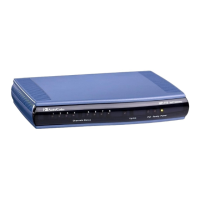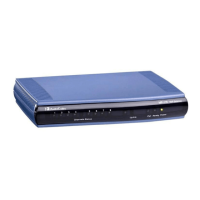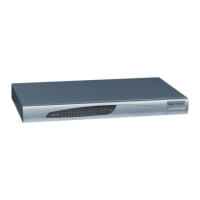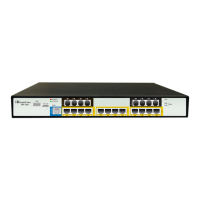SIP User's Manual 380 Document #: LTRT-65415
MediaPack Series
Parameter Description
Web/EMS: Authentication Mode
[AuthenticationMode]
Determines the device's registration and authentication
method.
[0] Per Endpoint = Registration and authentication is
performed separately for each endpoint.
[1] Per Gateway = Single registration and authentication for
the entire device (default).
[3] Per FXS = Registration and authentication for FXS
endpoints.
Typically, authentication per endpoint is used for FXS
interfaces, where each endpoint registers (and authenticates)
separately with its own user name and password.
Single registration and authentication (Authentication Mode =
1) is usually defined for FXO ports.
Web: Set Out-Of-Service On
Registration Failure
EMS: Set OOS On Registration Fail
[OOSOnRegistrationFail]
Enables setting an endpoint or the entire device (i.e., all
endpoints) to out-of-service if registration fails.
[0] Disable (default)
[1] Enable
If the registration is per endpoint (i.e., AuthenticationMode is
set to 0) or per Account (see ''Configuring Hunt Group
Settings'' on page 126) a
nd a specific endpoint/Account
registration fails (SIP 4xx or no response), then that endpoint is
set to out-of-service until a success response is received in a
subsequent registration request. When the registration is per
the entire device (i.e., AuthenticationMode is set to 1) and
registration fails, all endpoints are set to out-of-service.
Note: Te out-of-service method is configured using the
parameter FXSOOSBehavior.
[UnregistrationMode]
Determines whether the device performs an explicit unregister.
[0] Disable (default)
[1] Enable = The device sends an asterisk ("*") value in the
SIP Contact header, instructing the Registrar server to
remove all previous registration bindings.
When enabled, the device removes SIP User Agent (UA)
registration bindings in a Registrar, according to RFC 3261.
Registrations are soft state and expire unless refreshed, but
they can also be explicitly removed. A client can attempt to
influence the expiration interval selected by the Registrar. A UA
requests the immediate removal of a binding by specifying an
expiration interval of "0" for that contact address in a
REGISTER request. UA's should support this mechanism so
that bindings can be removed before their expiration interval
has passed. Use of the "*" Contact header field value allows a
registering UA to remove all bindings associated with an
address-of-record (AOR) without knowing their precise values.
Note: The REGISTER-specific Contact header field value of "*"
applies to all registrations, but it can only be used if the Expires
header field is present with a value of "0".

